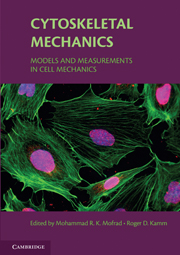Book contents
- Frontmatter
- Contents
- List of Contributors
- Preface
- 1 Introduction, with the biological basis for cell mechanics
- 2 Experimental measurements of intracellular mechanics
- 3 The cytoskeleton as a soft glassy material
- 4 Continuum elastic or viscoelastic models for the cell
- 5 Multiphasic models of cell mechanics
- 6 Models of cytoskeletal mechanics based on tensegrity
- 7 Cells, gels, and mechanics
- 8 Polymer-based models of cytoskeletal networks
- 9 Cell dynamics and the actin cytoskeleton
- 10 Active cellular protrusion: continuum theories and models
- 11 Summary
- Index
9 - Cell dynamics and the actin cytoskeleton
Published online by Cambridge University Press: 10 November 2009
- Frontmatter
- Contents
- List of Contributors
- Preface
- 1 Introduction, with the biological basis for cell mechanics
- 2 Experimental measurements of intracellular mechanics
- 3 The cytoskeleton as a soft glassy material
- 4 Continuum elastic or viscoelastic models for the cell
- 5 Multiphasic models of cell mechanics
- 6 Models of cytoskeletal mechanics based on tensegrity
- 7 Cells, gels, and mechanics
- 8 Polymer-based models of cytoskeletal networks
- 9 Cell dynamics and the actin cytoskeleton
- 10 Active cellular protrusion: continuum theories and models
- 11 Summary
- Index
Summary
Abstract: This chapter focuses on the mechanical structure of the cell and how it is affected by the dynamic events that shape the cytoskeleton. We pay particular attention to actin because the actin structure turns over rapidly (on the order of tens of seconds to tens of minutes) and is strongly correlated with dynamic events such as cell crawling. The chapter discusses the way in which actin and its associated binding proteins provide the dominant structure within the cell, and how the actin is organized. Models of the internal structure that attempt to provide a quantitative picture of the stiffness of the cell are given, followed by an in-depth discussion of the actin polymerization and depolymerization mechanics. The chapter provides a tour of the experiments and models used to determine the specific effects of associated proteins on the actin cycle and contains an in-depth exposition of how actin dynamics play a pivotal role in cell crawling. Some conclusions and thoughts for the future close the chapter.
Introduction: The role of actin in the cell
Eukaryotic cells are wonderful living engines. They sustain themselves by bringing in nutrients across their membrane shells, manufacturing thousands of individual protein species that are needed to sustain the cell's function, and communicating with the surrounding environment using a complex set of receptor molecules that span the membrane and turn external chemical and mechanical signals into changes in cell function and composition.
The cell membrane is flexible and allows the cell to move – and to be moved – by changes in the internal cytoskeletal structure. The cytoskeleton is a spatially sparse tangled matrix of rods and rod-like elements held together by smaller proteins.
- Type
- Chapter
- Information
- Cytoskeletal MechanicsModels and Measurements in Cell Mechanics, pp. 170 - 203Publisher: Cambridge University PressPrint publication year: 2006
- 2
- Cited by

